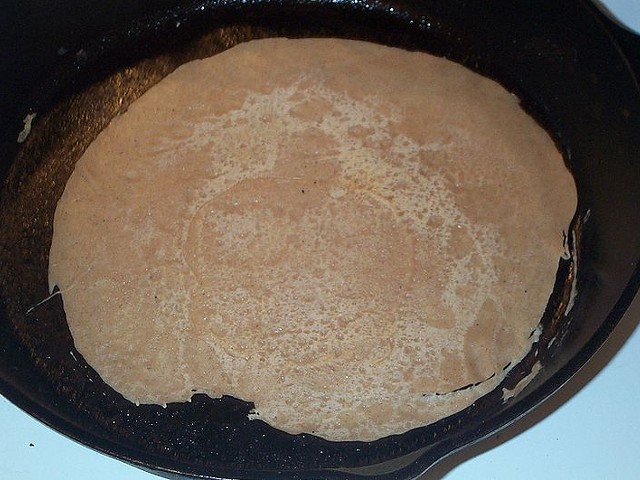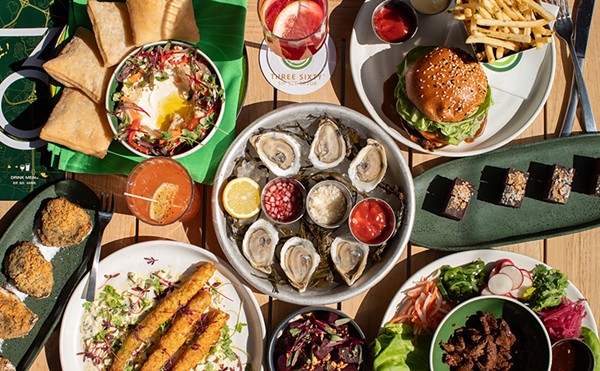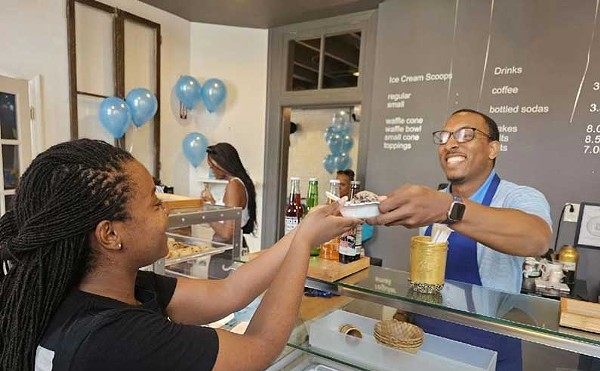When Mango Peruvian Cuisine opened in a Shrewsbury strip mall in 2004, it attracted interest as the only restaurant in St. Louis to serve the fascinating — and increasingly trendy — fare of the South American nation. Five years later Mango remains the area's sole Peruvian restaurant, but in September owner and chef Jorge Calvo opened a second location in the loft-district space vacated by Mosaic when it moved last year to a new spot just around the corner. While the new Mango's menu is similar to that of the original, which received a rave review from my predecessor, Rose Martelli ("Southern Exposure," December 8, 2004), the restaurant's downtown debut is significant.
For the past few years, the downtown restaurant scene has been stagnant. This isn't a complaint. I don't have to tell you about the awful economy. Which makes it even more remarkable that the restaurant to try to goose the scene is one that, even counting the fans of its original location, serves a cuisine unfamiliar to most diners.
Mango's layout will be familiar to those who dined at the old Mosaic. Just inside the entrance is a large bar area with stools arranged on all four sides of the bar itself, a few bar tables and flat-screen TVs. The dining area is directly behind the bar, its booths and tables partially blocked by freestanding dividers. To the left of the dining area (if you face the back wall) is the open kitchen. The décor has been toned down from Mosaic's day: The sleek, curvy bar and the waterfall are gone. In its place are sparse wall hangings; the soundtrack tends toward that Andean staple, the panpipes.
The menu is broad and will give you some idea of the complexity of Peruvian cuisine, an amalgam not only of Spanish and indigenous fare, but also of African, Japanese, Chinese and western European traditions. Even those dishes familiar to aficionados of other South- and Latin-American cuisines bring a twist or two: The pork tamal looks as expected, a cylinder of masa flour steamed, in this case, inside a banana leaf, but the texture might startle you, as very finely chopped or even ground peanuts contrast the exterior moistness with a slight crunch. The flavor is also surprising: The masa's sweetness and slight heat yields not to the savory pork, but to the briny snap of green olive.
Ceviche is a Peruvian standard, made here with a combination of shrimp and mussels or with tilapia. I opted for the latter version, which arrives in finger-size strips, with two discs of soft sweet potato and a few kernels of hominy on the side. Ceviche "cooks" food using the acids in citrus juice, so the first bite of the tilapia brought a stinging smack of lime and lemon tartness. A mild chile heat followed. There was no fish taste at all, which is probably for the best: Wild tilapia can have a muddy flavor, while to describe the farmed variety (what I had on my plate, most likely) as "mild" is to use too strong a word. A light-bodied, palate-sparking appetizer.
Most of the appetizers tend toward the simple and the pleasing, not least of which are the fried plantain chips served gratis with your meal alongside a bright, mildly spicy cilantro salsa. Empanadas are baked rather than fried, so the crust has a soft, light, pastry-like texture. The interior is a bracing blend of sweet peppers, raisins, olives and your choice of ground beef or chicken. I chose the ground beef and was glad: The meat had enough depth of flavor to match the olives. Of the appetizers, only pieces of fried yuca disappointed. The yuca itself was predictably bland, the flavor and texture something like a steak fry, but the "spicy dipping sauce" was too subdued, with a mellow flavor and very little heat.
Frankly, I don't have enough experience with Peruvian cuisine to say which entrée, if any, is most representative of the food as a whole. But in terms of how it can play with your expectations, I can think of no better example than ají de gallina. Ají amarillo is a yellow chile that is practically omnipresent in Peruvian dishes. Here it gives a sauce for shredded chicken and a few pieces of golden potato a striking mustard-yellow color. Yet the sauce isn't especially spicy; instead it offers an Italian-like blend of creamy, cheesy and nutty. That's not a critic's poetic license: The sauce contains ground walnuts, and Parmesan cheese is sprinkled atop it. The overall effect of the dish, served with a side of white rice, is comforting.
Seco de carne is sometimes described as Peruvian beef "stew," though seco translates as "dry." At Mango the dish is served on a plate and falls somewhere between heavily sauced and stewlike on the texture spectrum. The menu describes the beef as "cilantro-infused flank steak strips." These were very, very thin strips, or the beef had been shredded. Either way, the beef possessed the texture and, with garlic and onion, the depth of flavor you associate with long-simmered meat. The flavor of cilantro was absent, however; nor did I detect any of the promised hot pepper. Indeed, there was little distinctive about this dish, an impression amplified by the bland sides of rice and beans.
Beef fares better in the lomo saltado, which pairs strips of grilled meat with a mix of red onion, ají chile, tomato and whole steak fries. The dish, as a whole, looks something like fajitas minus the sizzle, and the onion and chile provide tart, spicy counterpoints to the beef. The fries — there are maybe a half-dozen of them — retain their crisp exterior fairly well. Steak fries also appear in the saltado de langostinos, which tosses perfectly sautéed shrimp with red onion, scallion, tomato and cilantro in a light, flavorful reduction of olive oil and white wine.
Both saltado dishes are served with white rice. Almost every entrée (pastas excepted) is. This isn't a problem, per se, but over the course of multiple visits I grew a little bored with the meat-starch template. Given the increased exposure Mango will receive downtown, it might be interesting to pepper traditional Peruvian dishes with some less-common fare. There are daily specials, though the roasted-pork special I ordered yielded three overcooked medallions in an undistinguished sauce.
The dessert list includes a terrific dish called pionono: sponge cake layered with thick, freshly made caramel. It's delicious, and light enough that even after a heavy meal you can enjoy it. The wine list focuses on South American reds and whites, most of them reasonably priced. Specialty cocktails include the Peruvian classic pisco sour and a nicely restrained (which is to say citrusy but not too sweet) sangría.
Like the dishes here that need more vibrant flavors, service in general at Mango could use a tad more seasoning. I encountered a dirty menu, a dirty plate on a freshly set table, servers who, while friendly, were far from prompt and sometimes too casual. (Example: Several servers stood around laughing at their incompetence at fixing a troublesome tap from which my beer was being poured — and then handed over the beer without asking me if it was OK.)
Issues like these stand out when you open in a high-profile location. But consider how far Mango has come in the past five years: What's significant isn't that St. Louis has a Peruvian restaurant, or even that it now has a Peruvian restaurant downtown, but that among the pricey lofts and slick eateries, Mango belongs.





